The AMD Trinity Review (A10-4600M): A New Hope
by Jarred Walton on May 15, 2012 12:00 AM ESTAMD Trinity General Performance
Starting as usual with our general performance assessment, we’ve got several Futuremark benchmarks along with Cinebench and x264 HD encoding. The latter two focus specifically on stressing the CPU while PCMarks will cover most areas of system performance (including a large emphasis on storage) and 3DMarks will give us a hint at graphics performance. First up, PCMark 7 and Vantage:
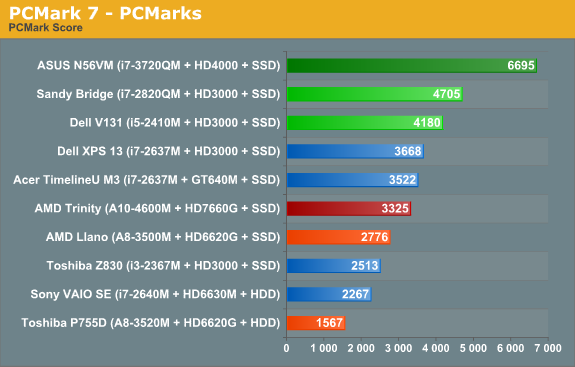
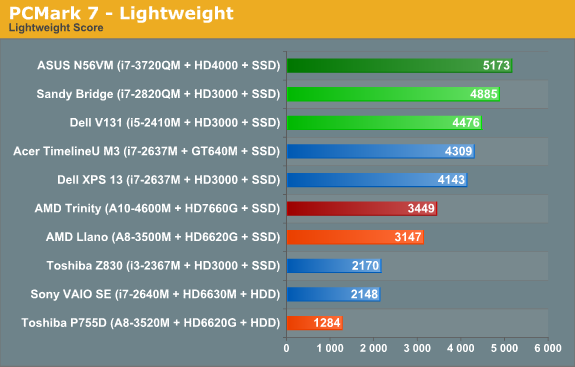
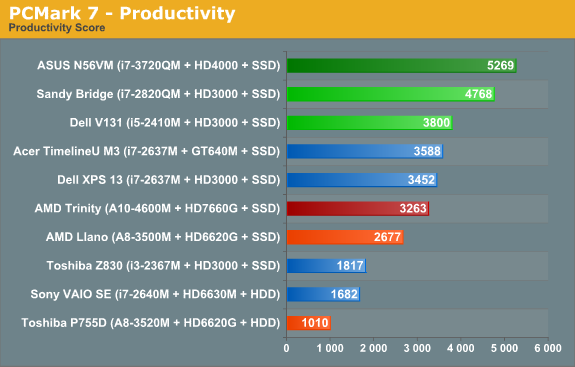

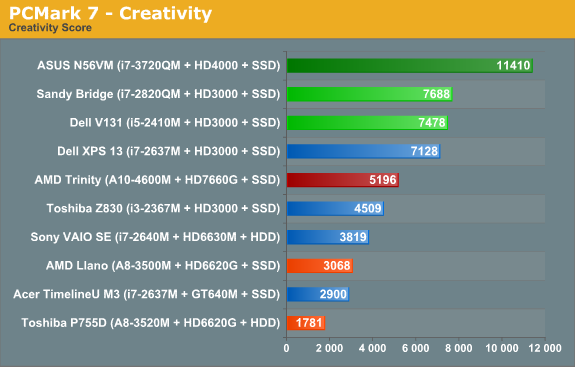
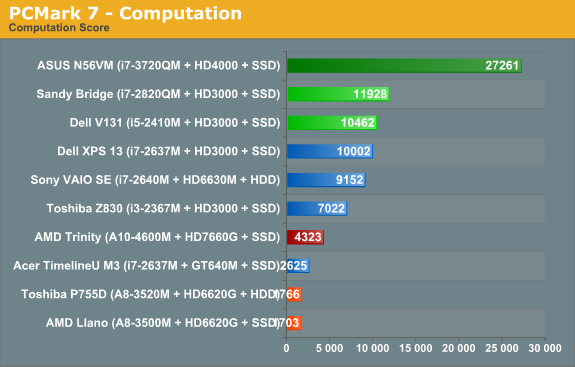
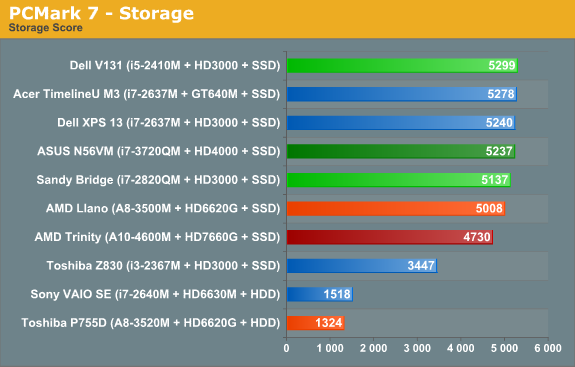
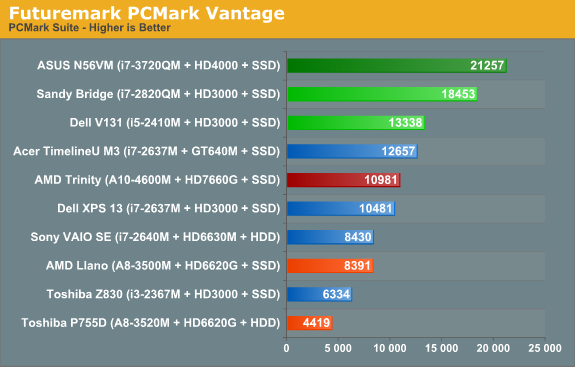
As noted earlier, we ran several other laptops through PCMark 7 and PCMark Vantage testing using the same Intel 520 240GB SSD, plus all the ultrabooks come with SSDs. That removes the SSD as a factor from most of the PCMark comparisons, leaving the rest of the platform to sink or swim on its own. And just how does AMD Trinity do here? Honestly, it’s not too bad, despite positioning within the charts.
Obviously, Intel’s quad-core Ivy Bridge is a beast when it comes to performance, but it’s a 45W beast that costs over $300 just for the CPU. We’ll have to wait for dual-core Ivy Bridge to see exactly how Intel’s latest stacks up against AMD, but if you remember the Llano vs. Sandy Bridge comparisons it looks like we’re in for more of the same. Intel continues to offer superior CPU performance, and even their Sandy Bridge ULV processors can often surpass Llano and Trinity. In the overall PCMark 7 metric, Trinity ends up being 20% faster than a Llano A8-3500M laptop, while Intel’s midrange i5-2410M posts a similar 25% lead on Trinity. Outside of the SSD, we’d expect Trinity and the Vostro V131 to both sell for around $600 as equipped.
A 25% lead for Intel is pretty big, but what you don’t necessarily get from the charts is that for many users, it just doesn’t matter. I know plenty of people using older Core 2 Duo (and even a few Core Duo!) laptops, and for general office tasks and Internet surfing they’re fine. Llano was already faster in general use than Core 2 Duo and Athlon X2 class hardware, and it delivered great battery life. Trinity boosts performance and [spoiler alert!] battery life, so it’s a net win. If you’re looking for a mobile workstation or something to do some hardcore gaming, Trinity won’t cut it—you’d want a quad-core Intel CPU for the former, and something with a discrete GPU for the latter—but for everything else, we’re in the very broad category known as “good enough”.


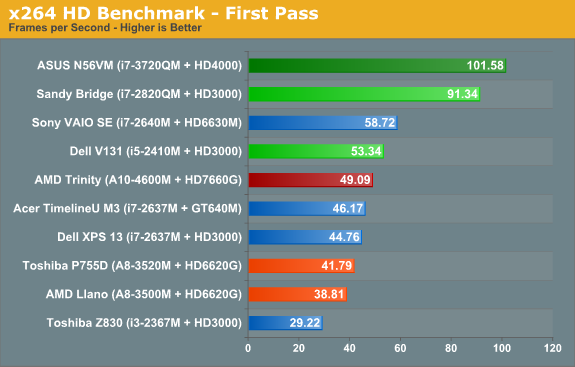
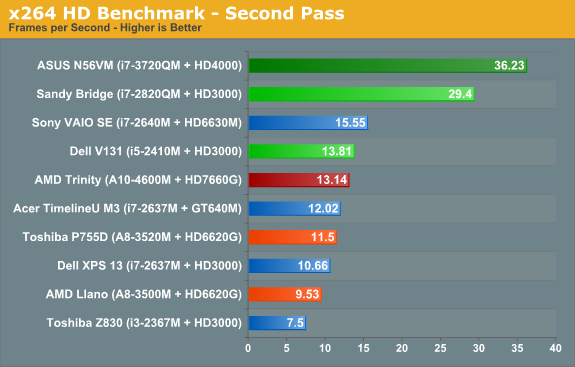
When we start drilling down into other performance metrics, AMD’s CPU performance deficiency becomes pretty obvious. The Cinebench single-threaded score is up 15% from 35W Llano, but in a bit of a surprise the multi-threaded score is basically a wash. Turn to the x264 HD encoding test however and Trinity once again shows a decent 15% improvement over Llano. Against Sandy Bridge and Ivy Bridge, though? AMD’s Trinity doesn’t stand a chance: i5-2410M is 50% faster in single-threaded Cinebench, 27% faster in multi-threaded, and 5-10% faster in x264. It’s a good thing 99.99% of laptop users never actually run applications like Cinebench for “real work”, but if you want to do video encoding a 10% increase can be very noticeable.

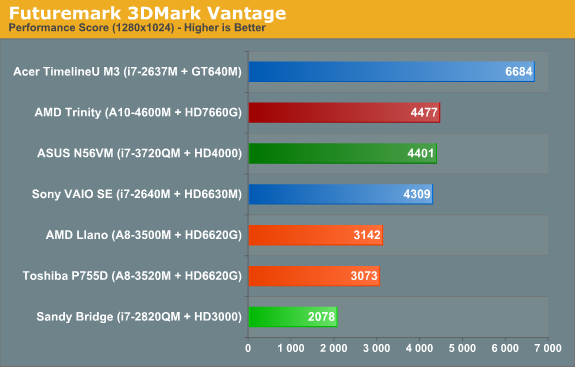
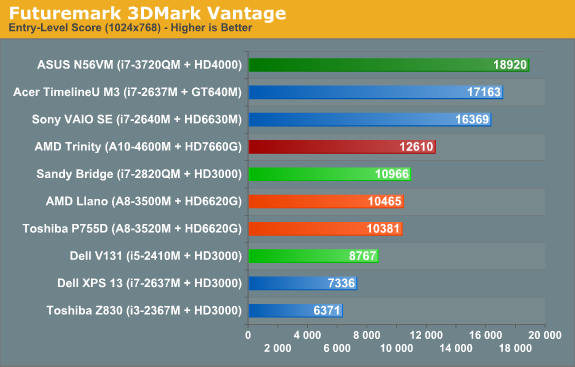
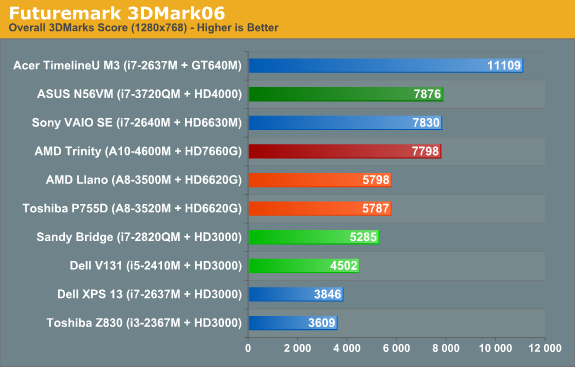
Shift over to graphics oriented benchmarks and the tables turn once again...sort of. Sandy Bridge can’t run 3DMark11, since it only has a DX10 class GPU, but in Vantage Performance and 3DMark06 Trinity is more than twice as fast as HD 3000. Of course, Ivy Bridge’s HD 4000 is the new Intel IGP Sheriff around these parts, and interestingly we see Trinity and i7-3720QM basically tied in these two synthetics. (We’ll just ignore 3DMark Vantage’s Entry benchmark, as it’s so light on graphics quality that we’ve found it doesn’t really stress most GPUs much—even low-end GPUs like HD 3000 score quite well.) We’ll dig into graphics performance more with our gaming benchmarks next.










271 Comments
View All Comments
JarredWalton - Tuesday, May 15, 2012 - link
I think it *needs* to be at $600 to sell, because SNB + GT 540M is already at $600. However, HP has hinted that their sleekbooks with Trinity will start at $600 and $700 for the 15.6" and 14" models, respectively. "Start at" and "comes with a reasonable amount of RAM and an A10 APU" are not the same thing. Until HP actually lists full specs and a price, I have to assume that the $600 price tag for the 15" model is going to be 4GB RAM, 250GB HDD, and an A6-4400 APU. Hopefully I'm wrong, but the fact is we don't know Trinity's real price yet, so in the article I'm referring to the price I think it should be at in order to provide a good value.hechacker1 - Tuesday, May 15, 2012 - link
As most people I assume are coming from the Core 2 Duo style laptops, I would like to see a comparison of trinity with that.I know core i processors are fast, but I don't know if AMD has caught up with Core 2 performance.
tipoo - Tuesday, May 15, 2012 - link
Even with Llano they had caught up, with Trinity the margin will only be larger. Use this to compare whatever you wanthttp://www.anandtech.com/bench/Product/399?vs=62
cosminmcm - Monday, May 21, 2012 - link
How about comparing Llano to a core 2 quad? And at about the same frequency.Here you go:
http://www.anandtech.com/bench/Product/399?vs=50
This Guy - Wednesday, May 16, 2012 - link
Sorry to be rude. I really think you missed the point of this chip.The CPU in Trinity is close to a 17W CPU with a 17W GPU. It performs about the same as an intel 17W chip. It's graphics engine is far better and the CPUs should cost about the same. The only real disadvantage over 17W Sandy Bridge is that in a prototype chasis Trinity uses more power, but a few watts should be shaved on production models.
This means AMD has caught up to Intel again! Yes AMD is going to lose spectacularly when ULV Ivy Bridge comes out and I doubt Trinity is going to scale at higher power but at low power, AMD has caught up!
(Yes I know that Sandy Bridge includes a GPU but if you look at your benchmarks, ULV Intel with a dGPU scores similar to Trinity when transcoding [The only really CPU limited test in this review])
ET - Wednesday, May 16, 2012 - link
Something I just read at The Tech Report: when using MediaEspresso to transcode video, the result of VCE was much smaller than QuickSync or software, yet they didn't notice a difference in quality. I would like to know what your experience was. If that's really the case I'd prefer VCE over other Intel's solution even if it's slower.Riek - Wednesday, May 16, 2012 - link
As far as i know VCE is not yet supported or been made available by AMD.All those tests are due to openCL and not VCE since that part cannot be reached at this point in time. (yes blame AMD for that one, this is already taking 6months and still their is nothing about VCE)
Spunjji - Wednesday, May 16, 2012 - link
You're mistaken, there.Quote from Page 2:
"Trinity borrows Graphics Core Next's Video Codec Engine (VCE) and is actually functional in the hardware/software we have here today. Don't get too excited though; the VCE enabled software we have today won't take advantage of the identical hardware in discrete GCN GPUs"
karasaj - Wednesday, May 16, 2012 - link
When you go to the llano review, the HD4000 gets stomped by Llano's desktop graphics offering. When you look at Trinity, the notebook version of trinity barely beats Llano. Why is it that Intel can practically fit the full power of their IGP (get nearly the same performance from notebooks as from 3770k) but AMD's is drastically weaker?Also - will we see a weaker HD4000 in the dual core/cheaper IVB variants? I think Trinity desktop GPU will stomp on the HD4000 and might actually be a viable budget gaming solution as long as CPU improvements are good enough. We could see it take down quite a bit of the discrete graphics market I think, considering the HD4000 already can do that.
JarredWalton - Wednesday, May 16, 2012 - link
It's an odd move by Intel, perhaps, but I think it makes sense. The mobile Sandy Bridge and Ivy Bridge parts basically get the best IGP Intel makes (HD 3000/4000), and what's more the clocks are just as high and sometimes higher than the desktop parts. Yeah, how's that for crazy? The i7-3720QM laptop chips run HD 4000 at up to 1.25GHz while the desktop i7-3770/K/S/T runs the IGP at up to 1.15GHz. SNB wasn't quite so "bad" with HD 3000, as the 2600K could run HD 3000 at 1.35GHz compared to 1.3GHz on the fastest mobile chips.Anyway, the reason I say it kind of makes sense is that nearly all desktops can easily add a discrete GPU for $50-$100, and it will offer two or even three times the performance of the best IGP right now. On a laptop, you get whatever the laptop comes with and essentially no path to upgrade.
For AMD, if you look at their clocks they have them cranked MUCH higher on desktops. The maximum Llano clocks for mobile chips are 444MHz, but the desktop parts are clocked up to 600MHz. What's even better for desktop is that Llano's GPU could be overclocked even further on many systems -- 800MHz seems to be achievable for many. So basically, AMD lets their GPU really stretch its legs on the desktop, but laptops are far more power/heat constrained. It will be interesting to see what AMD does with desktop Trinity -- I'd think 900MHz GPU core speeds would be doable.